-
Basque Piperade and Party Mouse finds our crack cocaine stash
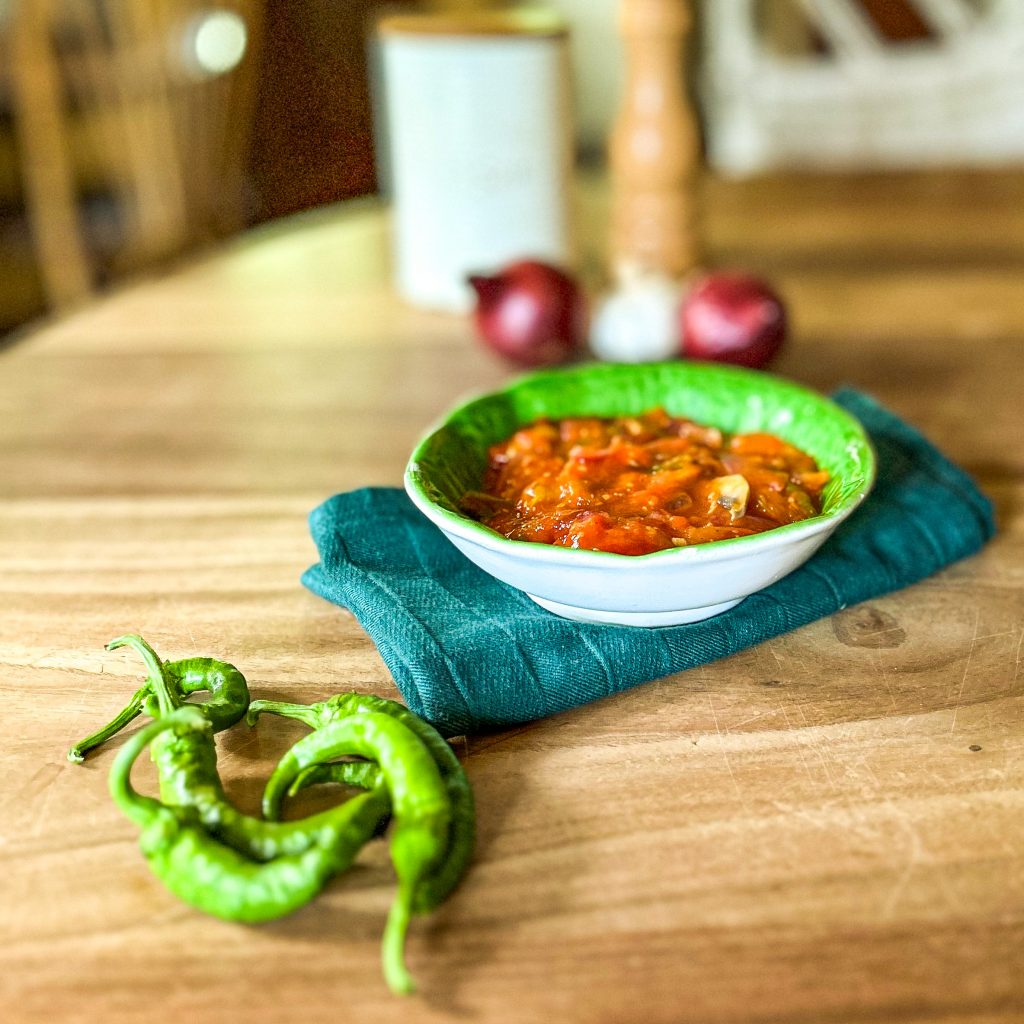
Basque Piperade I returned after two weeks away in August (a cruise around The Adriatic, which was very hot, but absolutely stunning. My photos are here if you’re interested), to even greater heat and forest fires far too close for comfort. Luc, who had stayed at home to look after the animals because he doesn’t really enjoy travelling anymore, had done a great job, with one exception: he had inadvertently invited a frenetic mouse into the house.
Living in the middle of the country, we see quite a few mice. But I have never seen a mouse as brazen as this one. At first, I noticed loud rustling noises in the cupboard, and holes in the pasta packaging. Then she (I’m calling the mouse ‘she’ because mice are feminine in French) started to drag and drop whole walnuts, potatoes, bits of dog food and, to my shame, enormous fluffballs across the kitchen floor at night, which means I come down to even more chaos in the kitchen than I have left the night before.
You’d think that the night-time activity might wear her out. Alas no! She spends her days playing ‘cat and mouse’ with us, peaking her nose out from under the cooker and fridge, and scuttling across the floor in front of us whenever we deign to sit down. She is upstairs, downstairs, in every nook and cranny and never seems to sleep.
I was seriously wondering where Super Mouse was sourcing her crack cocaine, when I stumbled across the reason for her hyperactivity: an enormous hole in the packet of ground Ethiopian coffee blend. Her drug of choice has now been confiscated, and she’s going to have to go cold turkey. It’s just a waiting game now… surely she’ll fall asleep at some point.
Basque Piperade originated in the Basque region, where sun-ripened tomatoes and peppers are plentiful.
Recipe for Basque Piperade (serves 6)
- 600g onions, sliced
- 3 cloves garlic, crushed
- 4 tablespoons olive oil
- 3 green peppers, seeds removed and sliced
- 6 mild red chilli peppers, seeds removed and sliced
- 1.5k tomatoes, skinned
- Sea salt, freshly ground black pepper
- Espelette pepper (or paprika)
Lightly fry the chopped onions and garlic in olive oil in a large saucepan. Skin the tomatoes by blanching in boiling water for a minute or so and then add to the dish. Cut the peppers into thin strips and add to the tomato mixture. Season with salt and pepper and Espelette pepper and leave to simmer on a low heat for at least an hour, or until the mixture begins to caramelise very slightly.
Traditionally, piperade includes beaten eggs cooked in the vegetable mixture. Often a thick slice of Bayonne ham is fried and served over the top. It is also good with fried or poached eggs on top.
-
Mirabelle plum tart and I take on a photo booth
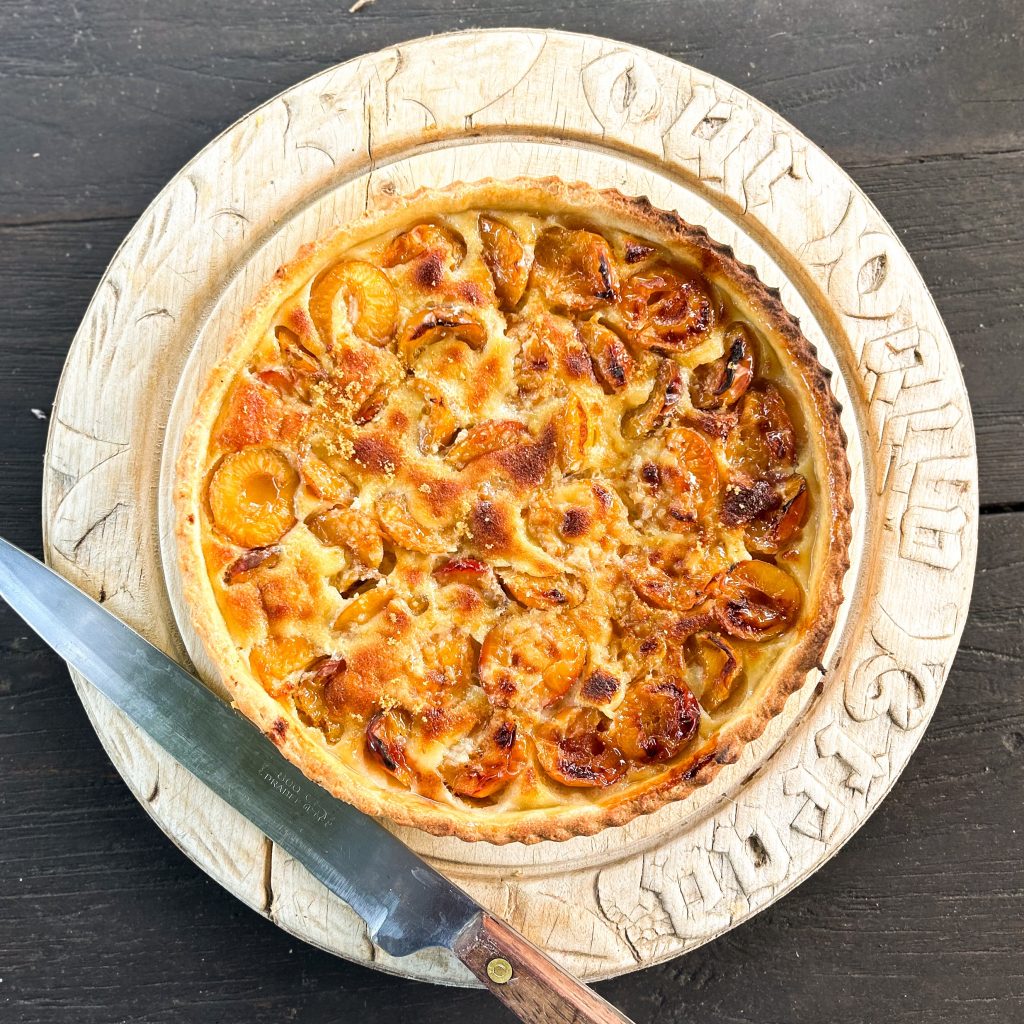
Mirabelle plum tart My iPhone reminded me of my appointment at the mairie to renew my identity card, I grabbed everything, or so I thought, and ran. Unfortunately though, I fell at the first hurdle; I’d forgotten my photos. I was dismissed, and given another appointment for the next day when I was told to ‘make absolutely sure I had everything with me’.
I found an extremely bossy photo booth and even managed, after a bit of haggling, to find the right change. Once the booth had taken my money though, it became even more obnoxious. It ordered me to sit still and remove my glasses, which I did, because its tone made me not inclined to argue. It then told me to read the small print. WTF? How on earth was I supposed to read the small print sans glasses? I bluffed my way through the tyrannical instructions, being extra careful to remove my all my earrings and especially NOT TO SMILE. There was little risk of me smiling; by this time, I was beginning to feel I would never smile again.
Luc was quite unsympathetic, saying that I turn every little thing, even the most mundane, into a Major Diplomatic Incident. At the mairie the next day, my application for a new ID card was declined, as my photos didn’t fit the bill: my hair was flying out of the frame, one of my ears wasn’t on show, and I was smirking, presumably from rapidly impending hysteria. So I now have to repeat the whole process. I actually prefer my chances of explaining my way out of an expired ID card, than taking on that photo booth again…
We have a mirabelle plum tree in our garden, and this is the first year it has borne fruit since it was planted 15 years ago. I often find plums very acidic, but ripe mirabelle plums contain hardly any acid and are very sweet, making them easy on sensitive stomachs.
Recipe for mirabelle plum tart (serves 4-6)
Puff pastry:
- 100g flour
- 50g butter, diced
- 1 egg
- 2 tablespoons water
- Pinch of salt
Filling:
- 18 (roughly) mirabelle plums, cut in half, stone removed
- 30g sugar
- 40g ground almonds
- 100ml cream
- 4 tablespoons fruit alcohol (I used calvados)
To make the puff pastry:
Mix the ingredients together in a mixer, wrap in clingfilm and refrigerate for at least 3 hours, or even overnight. Roll the pastry out (remember to sprinkle flour on your work surface), and fold and roll several times, remember to turn the pastry 90° each time. Wrap in clingfilm and refrigerate again. To use the pastry, just roll out again according to the shape of your pastry case.
To make the filling:
Arrange the plums in the pastry case, then mix the other ingredients together and pour over the fruit. Bake in a very hot, preheated oven (220°C) for 30 minutes. May be served hot, lukewarm, or cold.
-
Chili con carne and courgette gratin, a pedant jeweler, and travels with my parcel
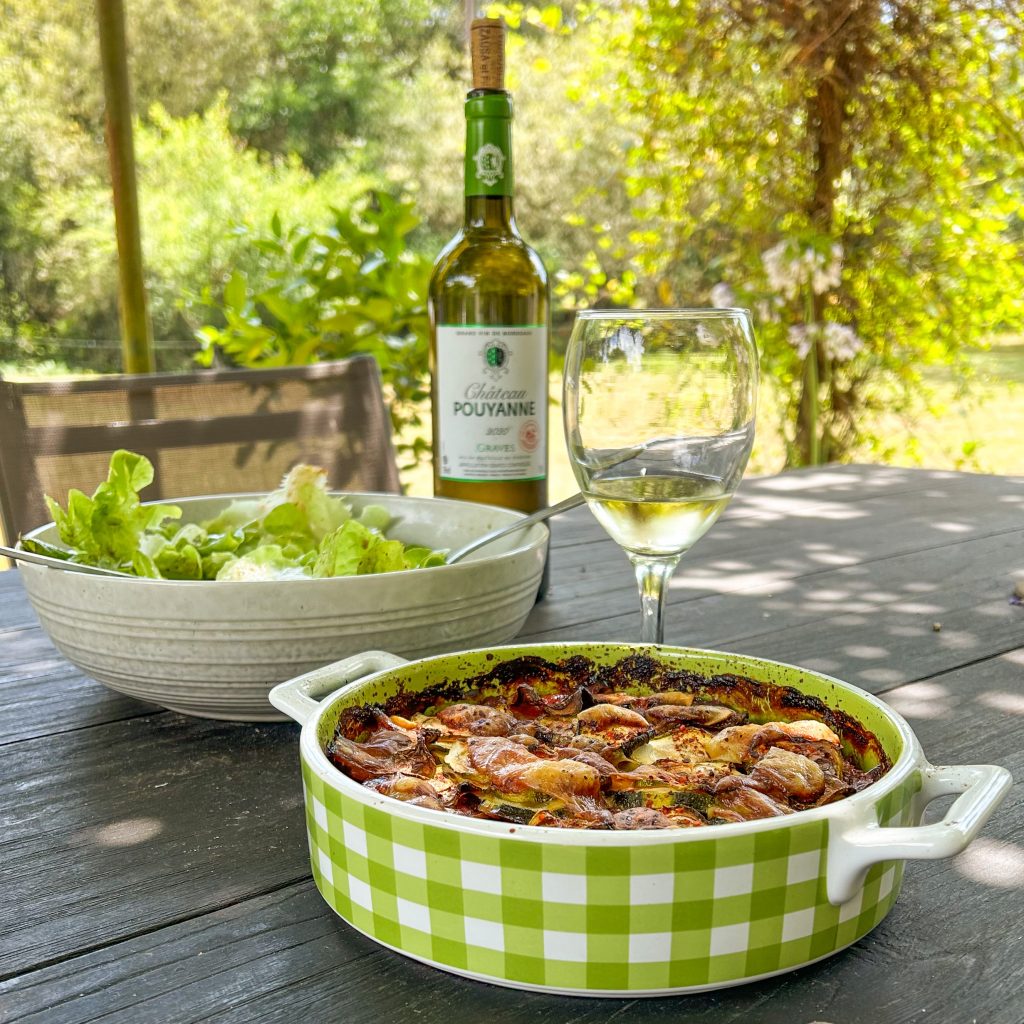
Chilli con carne and courgette gratin I drove 30kms last week to have my watch battery replaced. The jeweler, who was very patient and more interested in nurturing her inner teacher than her inner profiteer, took the time to show me that the big hand was on the 10, and the little hand was on the three. She said this meant that the watch was showing 3:10, and as it really was 3:10, the watch battery was still working. She then went on to compliment my very blond hair and blue eyes; it was only once I’d left that I realised the subtle point she had been making!
Since Brexit, it has become exceedingly expensive and complicated to send packages to the UK from Europe. Also, the sender is now inundated by far too much information. I recently sent a parcel which took 10 days to arrive. Every single day, I was the delighted recipient of intricate details of its progress. For the record, I’m OK with not knowing when it leaves the post office, when it gets into the van, when it sets off, when it crosses the border, when it stops for a potty break… What next? It’ll be setting up a Tiktok account and papping the posties.
What a boar!
A few evenings ago, hearing a terrible commotion coming from the forest, Leo’s immediate reaction was to ask where Java was. I assume this was based on the premise that where there is Java, there is commotion. Java is currently going through a bit of a phase: Despite angelic airs, her leaning definitely tends more towards criminal than cherubic. As it turns out, it had nothing to do with poor Java, who was snoring on a sofa. (It used to be we blamed it on the boogie; now, apparently we blame it on Java.) The neighbours’ dog had attacked some wild boar, which caused the neighbour and her daughter to escape up a tree, out of harm’s way. When Léo arrived to rescue the damsels in distress, they were still stuck half way up the tree, yelling futile instructions at their dog to leave the boars alone. Java, meantime, was still snoring on the sofa.
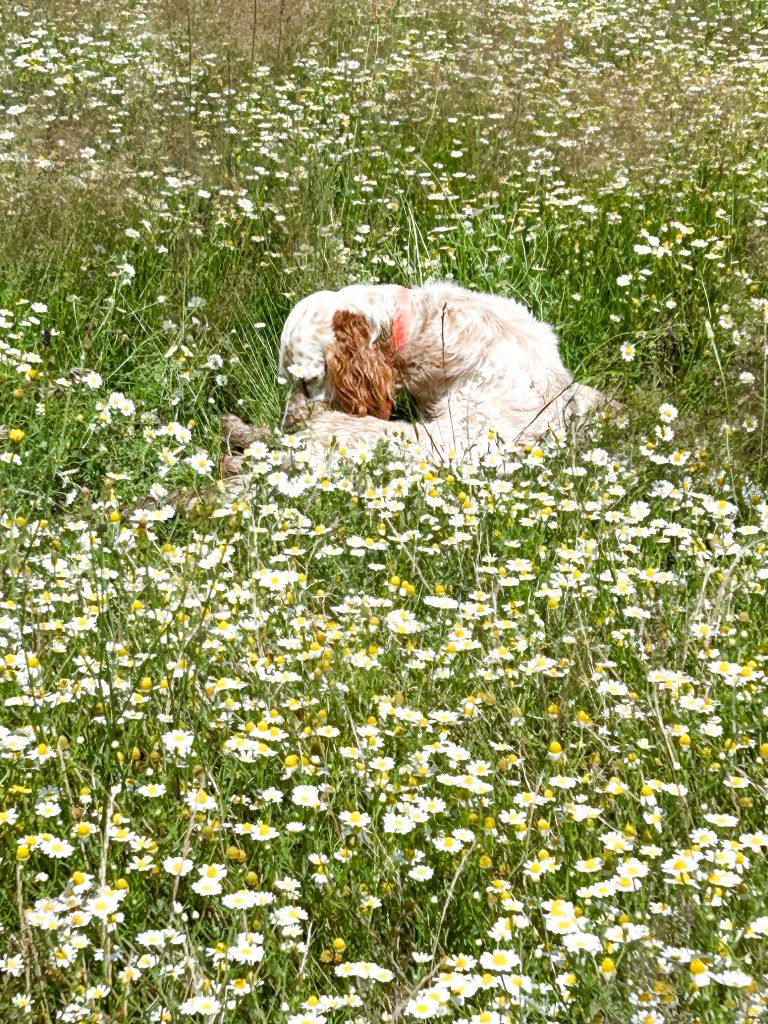
‘Angelic’ Java Although in Texas and Mexico where chili con carne originated, it is usually served with tortilla chips, I like this variant as the courgettes cool and complement the spices beautifully.
Recipe for chili con carne courgette gratin (serves 4)
- 250g pre-cooked red kidney beans
- 500g minced beef
- 2 tablespoons of olive oil
- 2 medium onions, chopped
- 2 cloves of garlic, crushed
- 6 tomatoes, blanched and skinned
- 1 red bell pepper (cut into strips)
- 4 chilli peppers (sliced)
- 6 mushrooms, peeled and sliced
- 2 tablespoons of tomato purée
- 2 glasses of red wine
- 250ml beef stock
- 1 sprig of rosemary and 2 bay leaves
- 1 tablespoon Worcester sauce
- 1 square of 80% dark chocolate
- Seasoning to taste : sea salt, black pepper, chilli powder
- 3 courgettes, cut into rounds
- Conté (or any other hard cheese), grated
Pour the olive oil into a medium-sized casserole dish and heat. Add the onions, garlic, mushrooms and mince and brown well, stirring around a bit. Once browned, add the bell pepper, the chilli peppers and the tomatoes and continue to cook until gently simmering. Add the tomato purée, the kidney beans, Worcester sauce, seasoning, stock, red wine and herbs and bring back to a simmer. checking from time-to-time that there is enough liquid. Add the dark chocolate, stirring well to melt, then place the chili in an oven-proof dish and cover with the courgette rounds and finally the grated cheese. Cook in the oven, preheated to 180°C, for about 45 minutes, or until the courgettes have softened and the cheese is bubbling.
-
Chocolate coconut slices, the great collapse, and chatting with birds
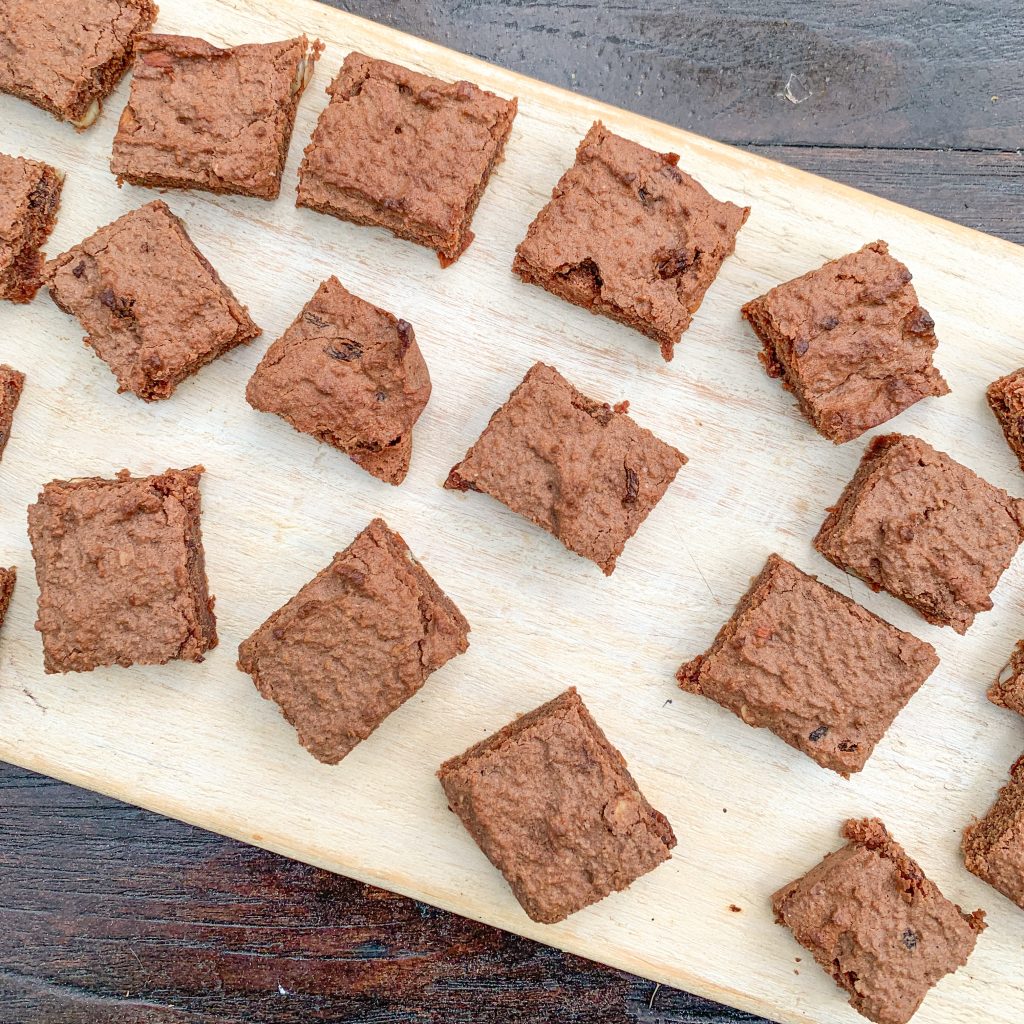
Chocolate coconut slices On the evening of the fifth anniversary of my father’s death in mid-June, Luc and I wandered over to the bench which bears a memorial plaque for him. I, naturally, was feeling mournful, but it was a beautiful evening and we decided to sit down for a bit. As we sat down, in perfect unison, the bench groaned and creaked, before squeaking and crying out in pain and finally disintegrating beneath us. All in slow motion. We ended up on our backs, feet in the air with looks of vague alarm on our faces. The alarm morphed quickly into hysterical laughter, and I felt as though my father and his legendary sense of humour had reappeared and were laughing with us; he would have absolutely loved it and, although unplanned and random, it was a wonderful way to remember him!

The bench that was Yesterday I found a little bird perched on a bookcase upstairs; I showed him the open window, but he returned resolutely to his adoptive bookcase. When he was still there several hours later, no doubt ensconced in a gripping page-turner, I slid a baking tray under him and took him downstairs. He still seemed to lack the resolve to fly away, so I offered him a cup of coffee (in reality it was water before anyone reports me to the RSPB), and I we had a little chat, which obviously bored him enough to inspire him to take wing. It was another very sweet moment.
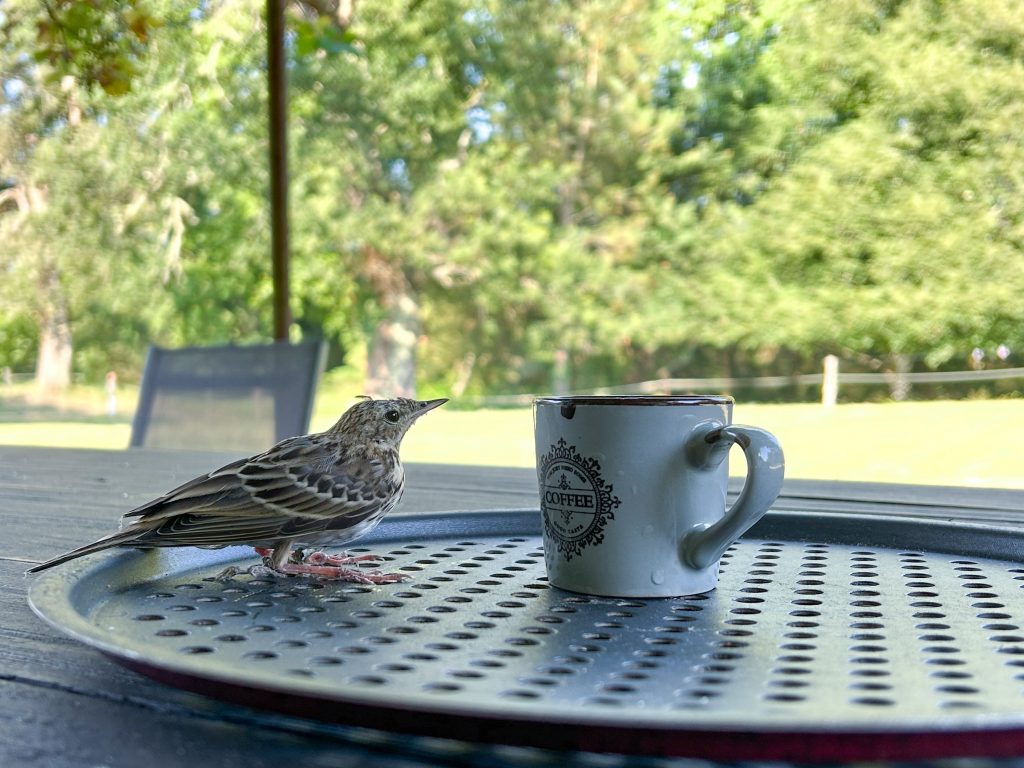
The little bird that stayed for coffee These coconut slices make ideal energy bar, without being too sweet. They’re very transportable so I use them when I know I might be in a situation when I need to eat a little something on the move. The almonds and coconut are good sources of protein, and also calcium, copper, iron, potassium, sodium, manganese, B vitamins, zinc, copper, and iron.
Recipe for chocolate coconut slices (makes 20)
- 2 eggs
- 75g cane sugar
- 125g coconut oil, melted
- Chopped almonds
- 100g raisins
- 125g flour (I used spelt flour)
- Pinch of salt
- 2 tablespoons cocoa powder
- 50g dessicated coconut
- 2 tablespoons rum (optional)
- Vanilla essence
Preheat the oven to 180°C. Prepare a baking tray by covering with greaseproof paper. Beat the eggs and sugar together until pale, and gradually add the coconut oil at the end. Combine the almonds, raisins, flour, salt, cocoa powder and coconut in a separate bowl and gradually add to the egg/sugar/oil mixture to obtain a thick paste. Finally stir in the rum and vanilla essence. Spread over the greaseproof paper on the baking tray and bake for 30 minutes. Cut into squares while still warm. Keeps in an airtight tin for several weeks, or may be frozen.
-
Asparagus quiche and tasered into oblivion
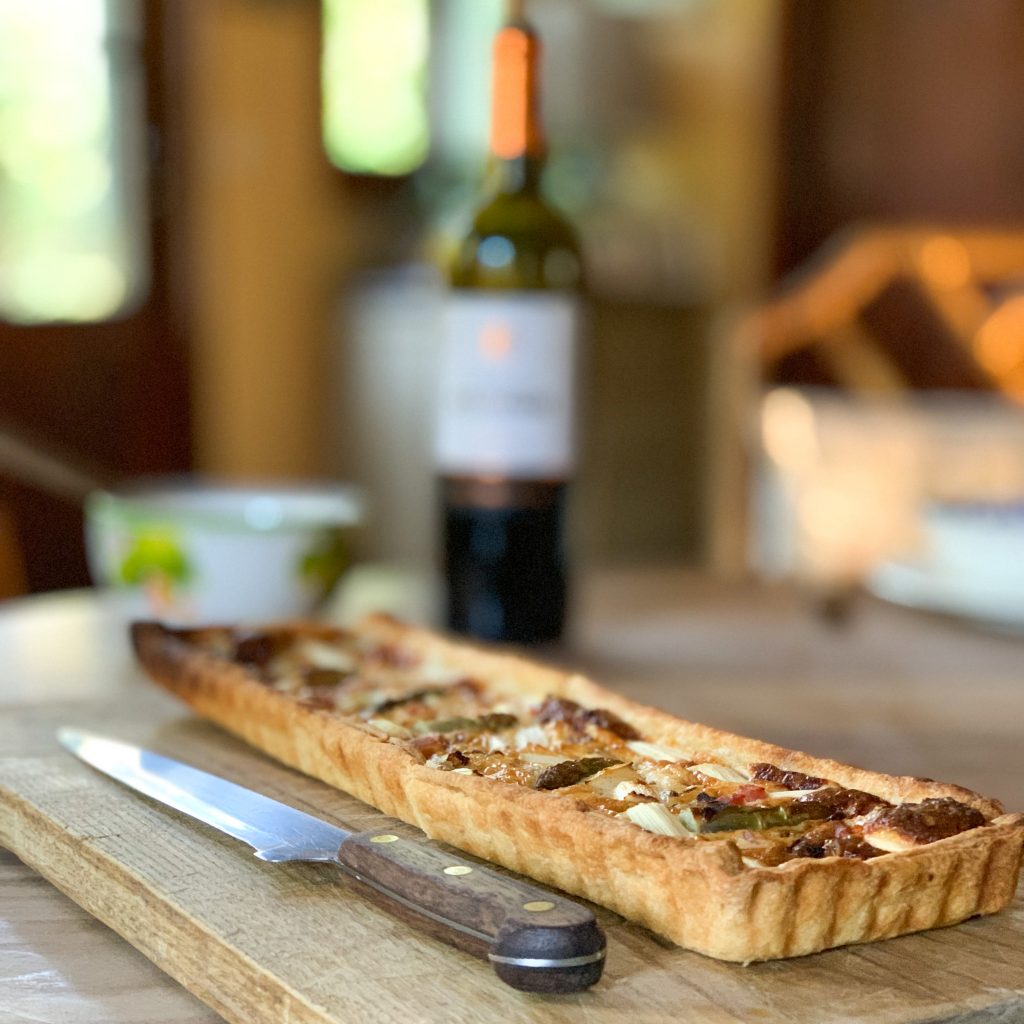
Asparagus quiche ‘I’ve forgotten my passport’, I yelled urgently to Luc as we turned onto the motorway towards Bordeaux. He reassured me that everything was under control, and that I wouldn’t be needing my passport for this trip. Little did I know just how apt the word ‘trip’ was going to prove . I’m generally not good with medical establishments, and total denial that I was on my way to spend a few days in one was my way of coping. I wasn’t heading to the airport, but a pain management clinic (for EDS).
As soon as we arrived, I told Luc he could ‘abandon me’, martyr-style. He did just that, quickly and without hesitation, probably before I could change my mind. I could hardly blame him though: The poor man had spent over an hour in the car with me, listening to me whine and invent crazy excuses to get out of my upcoming confinement.
Stoned
As it turns out, my fears were groundless. I basically attended a five-day rave, spending the majority of my time out of my mind on ‘Special K’ (ketamine: a horse tranquilizer). Admittedly some of the treatments were less relaxing; being tasered (or electromagnetic field therapy as they insist on calling it), for example, although I suspect the ketamine meant that I could be run over by a truck, and not be too fazed. I was a little worried about the ‘suicide vest‘ I was kitted out with for the sleep study, especially as I have a tendency to electrocution. When I mentioned my concern to the technicien, he just said ‘don’t worry, in theory it should be fine’. I felt like saying: ‘You don’t know me, if there’s someone who’ll manage to detonate a sleep study outfit, it’s me!’
If at all possible, try to make the most of asparagus while it’s in season; It is a fantastic source of antioxidants, folate, fibre, vitamins and minerals.
Recipe for asparagus quiche (serves 6 – 8)
Ingredients for pastry:
- 220g flour (I used spelt flour)
- 100g butter
- Cold water
Ingredients for filling:
- 4 asparagus, peeled and cut into rounds
- 1 tablespoon of olive oil
- 2 shallots, sliced
- Sea salt and freshly ground black pepper
- 1/2 teaspoon nutmeg
- 2 eggs
- 150 ml double cream
- 50 mg Cheddar, Parmesan or Comté cheese, grated
To make the pastry, begin by cutting the butter into small cubes. Add to the flour in a mixing bowl and add a pinch of sea salt. Blend by hand until the mixture becomes crumbly. Add the cold water, mixing rapidly with a spoon. Remove the mixture from the bowl onto a lightly floured surface. Knead until you obtain a ball of pastry (if the mixture isn’t ‘sticky’ enough to form a ball, you may need a drop more water). Wrap in a clean cotton tea towel and leave to ‘rest’ in the fridge for about two hours. This relaxes the dough and makes it easier to use. Preheat the oven to 200°C. Roll out the pastry on a clean, lightly floured surface and line the tart tin.
For the filling, begin by frying the asparagus rounds and sliced shallots in a little olive oil, then arrange in the pastry case. Break the eggs into a small bowl and add the cream and seasoning (salt, pepper, nutmeg). Beat well to form a homogenous mixture. Add some grated cheese and then pour the egg and cream mixture over the top. Cook at 200°C for 25 minutes, or until the top is golden-brown.
-
May: Ehlers Danlos Syndrome awareness month

The zebra is the symbol of Ehlers-Danlos syndrome because ‘sometimes when you hear hoofbeats, it really is a zebra’. May is Ehlers Danlos Syndrome awareness month. Ehlers Danlos Syndrome (EDS) is a group of disorders of the connective tissues. Connective tissue is found throughout the body, so the whole body can be affected due to defects in the structure and biosynthesis of collagen. There are 13 subtypes of EDS, but the most common is Hypermobile EDS (or hEDS), which is the type I have. Dysautonomia and MCAS (mast cell activation syndrome) are common comorbidities; I have both, having hit the trifecta jackpot!
Symptoms
The main symptoms of hEDS are pain, fatigue, allergies, gastric issues, joint laxity, muscular pain, stretchy skin, dizziness, brain fog, problems with proprioception, migraines, ADHD… In my case, this translates as: Countless fractures, sprains and dislocations; constantly walking into door frames; being able to spot someone wearing perfume from 500 meters, and a brain so distracted that thirty tabs are open, lights are flashing, and the music is on full blast at any one time. I also faint if I have to stand still for any length of time, which makes for great fun at border control! (I’m really selling myself here ;-))
I was diagnosed in with hEDS in late 2021, after The Vaccine exacerbated my symptoms to a point where I could no longer ignore them. Good nutrition is absolutely paramount to managing Ehlers Danlos, as so many of the complications are of a gastrointestinal and allergic nature. Bearing in mind that the aim is to reduce immune reactions, normalise gut bacteria and support digestion, absorption and metabolism, it’s best to limit sugar and refined carbohydrates, keep processed foods to an absolute minimum and consider cutting out gluten.
Exercise is also key, and luckily for me, riding is especially beneficial. Things like yoga, walking, cycling and swimming are also very helpful, although I have to be careful with yoga as I’m very prone to subluxations of the hips and shoulders.

-
Cranachan and the Stone of Scone
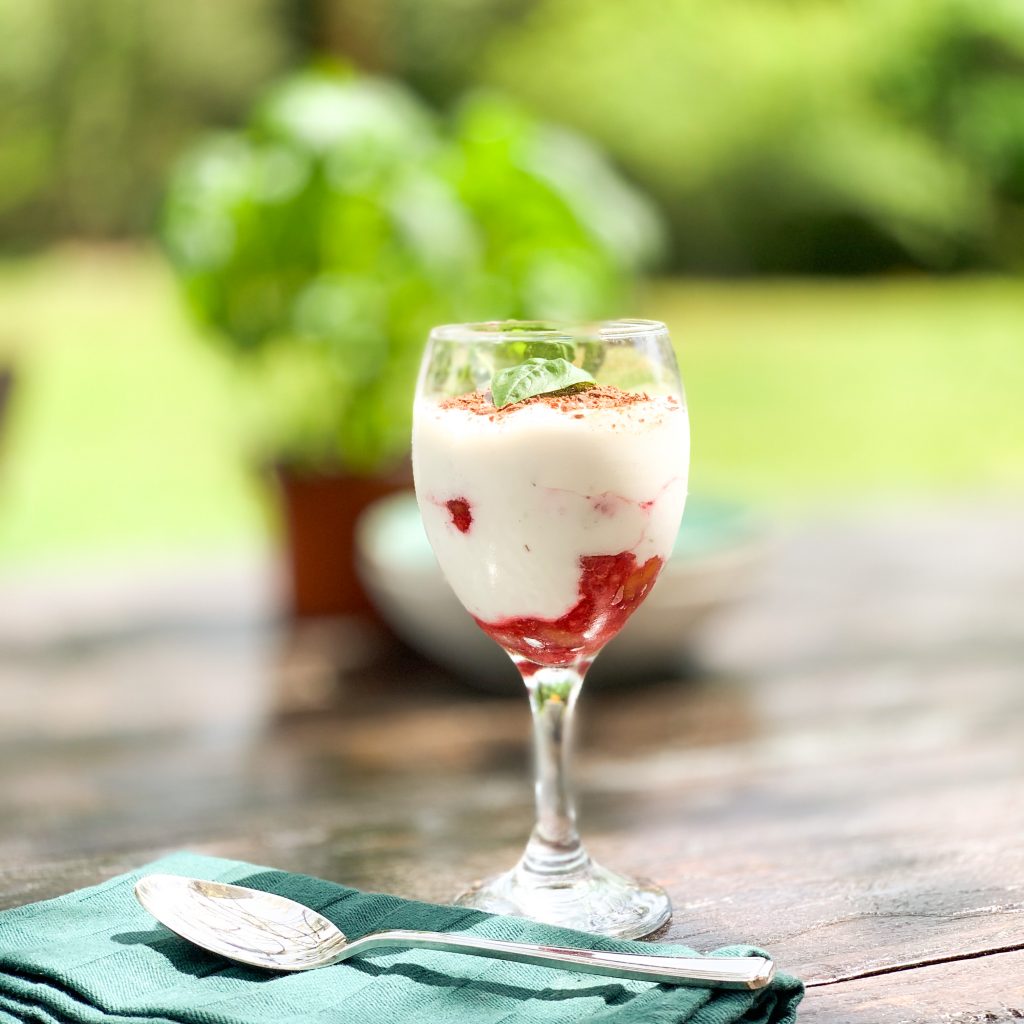
Cranachan The Stone of Scone, or the Stone of Destiny, is a 152kg block of red sandstone that would have been placed under the 700-year-old coronation chair yesterday. Historically it was used during the coronations of Scottish monarchs, and then the coronations of the monarchs of England, Great Britain and the United Kingdom.
My great uncle’s garage
The stone is well travelled — Westminster Abbey, Scone Abbey, Arbroath Abbey, and more recently, Edinburgh Castle. And in 1950, it travelled to my great uncle’s garage in Glasgow, having been stolen from Westminster Abbey by four Scottish students, who wanted to make a statement about Scottish nationalism. As my great uncle was a renown (and from memory, very vocal) member of the Scottish Covenant Association, who were campaigning for a Scottish Parliament, they passed the stone to him, which is how it ended up skulking in his garage.
As a child, I used to love visiting my relatives and their garages in Scotland in June, during the raspberry harvest. Raspberries were — and still are — one of my favourite fruits. Cranachan is the Scottish version of Eton mess, originally made to celebrate the harvest. The word cranachan means ‘churn’ in Gaelic. The almonds and chocolate are my addition, and not part of the original recipe. Apparently going rogue runs in the family!
Recipe for Cranachan (serves 4)
- 2 tablespoons oats
- 1 tablespoon almonds, chopped
- 300g raspberries, crushed
- 350ml double cream
- 2 tablespoons honey (heather honey if possible)
- 2 tablespoons whiskey
- 2 squares dark chocolate (minimum 70%), grated
Toast the oatmeal and almonds until rich and nutty and then leave to cool. Whisk the cream until just set, and then stir in the honey and whisky. Stir in the oatmeal and whisk lightly until the mixture is just firm. Alternate layers of the cream with the raspberries and purée in 4 serving dishes. Allow to chill slightly before eating.
-
Salmon and fennel tagliatelle and my fluorescent spring
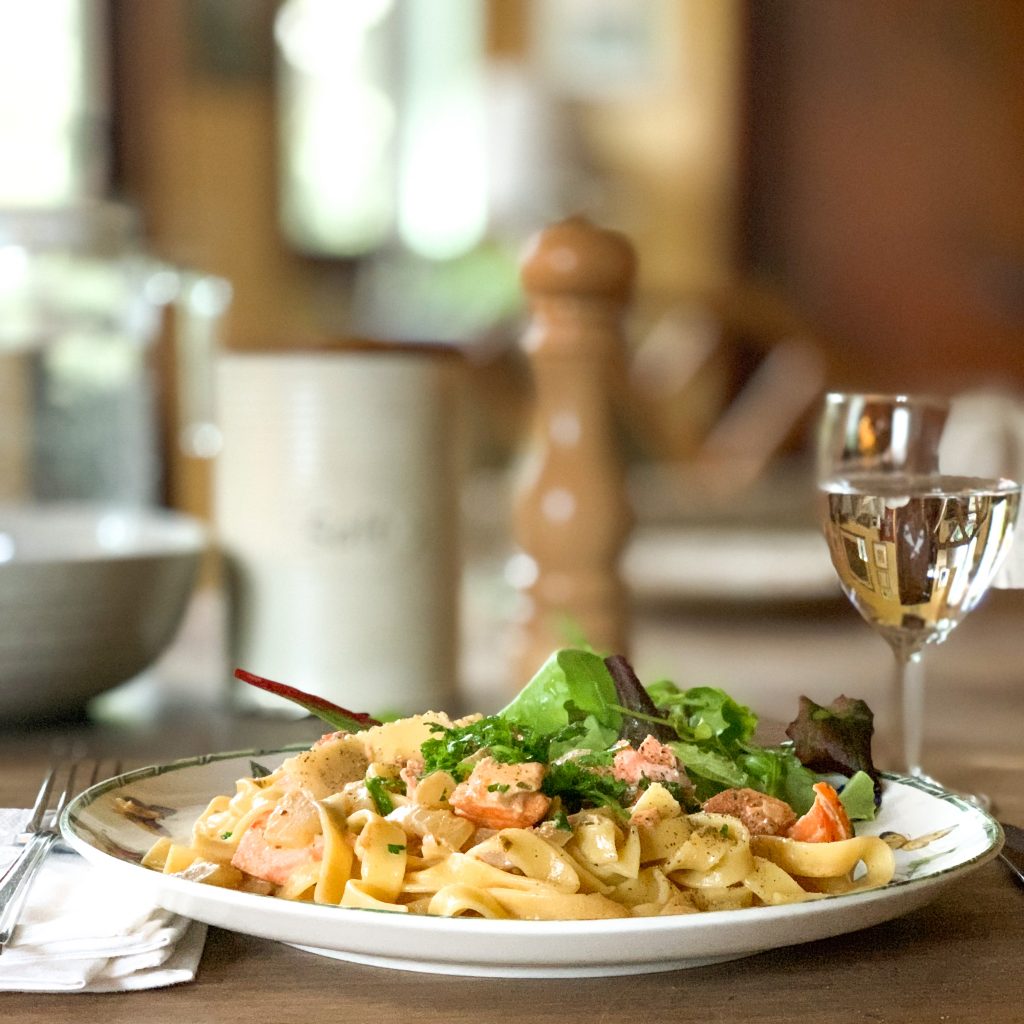
Salmon and fennel tagliatelle Well that was awkward: I just had to call the vet to say that Java wouldn’t be able to make her 3pm appointment because I couldn’t find her. Embarrassment-wise, it was on a par with the time I turned up to the vet appointment, on time but minus dog. Java came back a couple of hours later, having apparently taken part in a mud wrestling contest, before putting herself through an aggressive washing machine rinse cycle. I dragged her to the vet anyway, where there was a man asking for something for his parakeet’s itchy eyes. WTAF? Full points to parakeet owner though, for noticing his parakeet’s bothersome eyes. And zero points to me for failing to kit her dog out with a straitjacket.
Pine tree pollen is falling thick and fast, which means that everything has a thick covering of fluorescent yellow dust. (Perhaps this was the parakeet’s problem.) I bumped into a neighbour yesterday — quite literally as it happens; the layer of pollen on my glasses was that thick — who said that it was a sign that the coming winter would be very cold. I said that I couldn’t look that far ahead at the moment, as I was desperately trying to get through the spring without causing myself grievous bodily harm.
A few weeks ago I talked about Luc’s beloved tractor falling sick. It’s back home again, fighting fit, much to its devoted owner’s absolute delight. While I’m very happy for them, I can’t help feeling as if his mistress has come back, lithe and tanned from a long holiday. Especially when he says things like ‘when are we eating, have I got time to take the tractor out for a quick spin?’
The benefits of fennel for digestion
Alone in my kitchen, like a tractor widow, I tend to use fennel quite a lot. Fennel is part of the anise family and very commonly used in Mediterranean cuisine. It is one of the best vegetables for digestive problems and contains a cocktail of essential oils that give its characteristic aniseed smell. The chemicals contained in the essential oils are powerful antispasmodics, meaning they help to relax the wall of the gut. Use with immoderation!
Recipe for salmon and fennel tagliatelle (serves 4)
- 2 tbsp olive oil
- 1 onion, chopped
- 1 fennel bulb, chopped
- 1 garlic clove, crushed
- 125ml dry white wine
- Sea salt and freshly ground black pepper
- 1/2 teaspoon chilli powder
- 200g tagliatelle
- 200g salmon filets, precooked and sliced
- A handful of chives, chopped
- 50ml crème fraîche
- Parsley, freshly chopped
Heat the olive oil in a medium frying pan and ad the onion, fennel and garlic. Cook until the fennel softens. Add the wine and seasoning and simmer until the liquid reduces by about half. Meanwhile cook the tagliatelle. Add the salmon, chives and crème fraîche to the frying pan, mixing well. When the tagliatelle is cooked, combine in the frying pan and sprinkle with parsley.
-
Pasta with broccoli sauce and narcoleptic hamsters
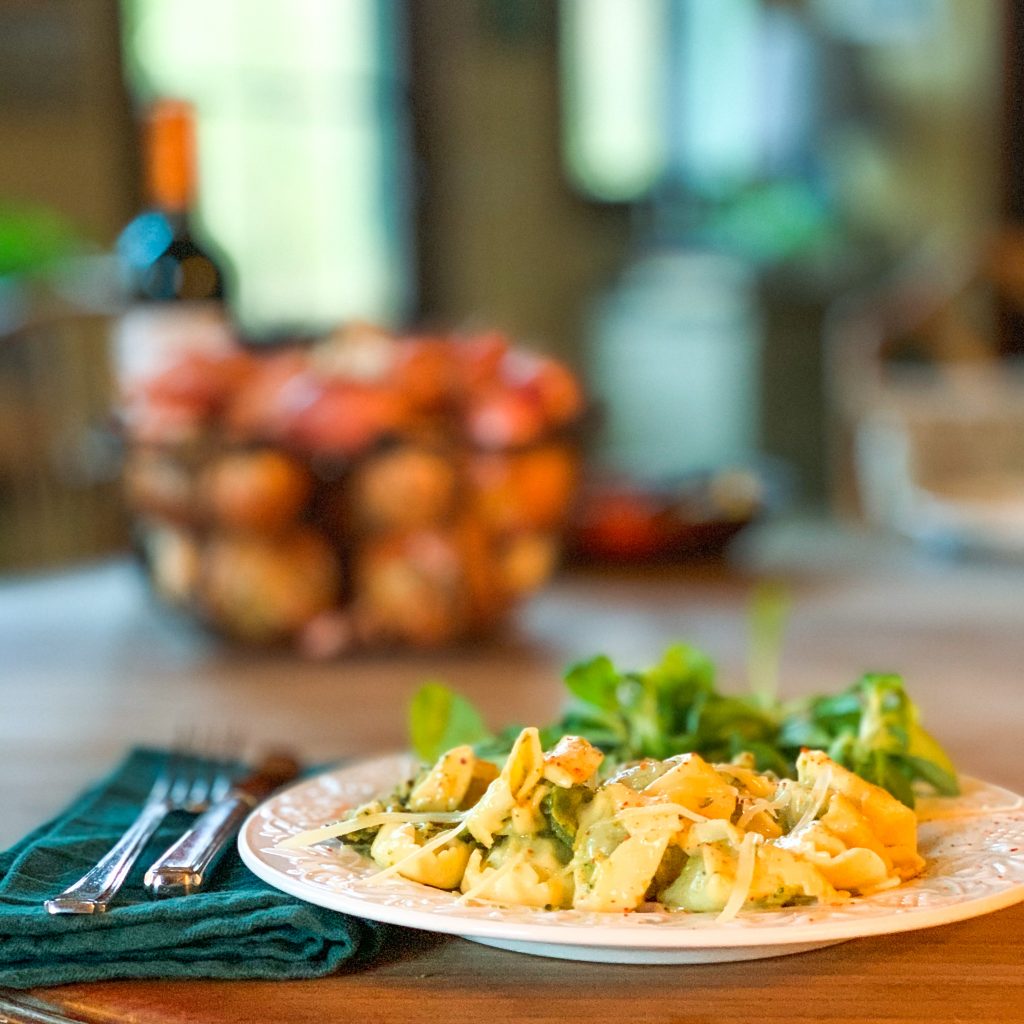
Pasta with broccoli sauce I am half way through a thermal cure at the moment. In France, if you have a painful body and a doctor’s prescription, you’re good to be smothered in healing mud, and soaked in thermal water for three weeks. You might think that three weeks of pampering would be relaxing, make you happy, and possibly even alleviate the need to whinge. And it is for most people. With the exception, of course, of the person that constantly insisted on seeking me out. She had issues. In fact, her issues had issues: The water was too warm, the therapists late (three whole minutes in one case, can you believe?), the massages too tiring, the food too filling, the coffee too strong, the mineral water too ‘minerally’, and the sun too bright. The upshot was that she decided that she wasn’t coming back. I said that I was certain that a little ray of sunshine like her would be sorely missed; she was so distracted naval gazing that she took the comment at face value.

The vines and their hamsters My hairdresser, who is a hunter (incongruous, but true), told me that this year, we should fill used tights with human hair to keep the grape-bud-munching deer at bay. Following last year’s catastrophe, when the deer ate the buds as soon as they appeared, we were ready to try anything. Except that now I crick my neck doing a double take every time I look at the vines with the narcoleptic, overweight hamsters bobbing in the breeze. I think I preferred the deer!
Health benefits of broccoli
Broccoli contains glucoraphanin , a compound that converts into a potent antioxidant called sulforaphane during digestion. It also contains the antioxidants lutein and zeaxanthin, which prevent oxidative stress and cellular damage in your eyes. Broccoli also contains bioactive compounds that reduce both inflammation and insulin resistance in the body. It is rich in fibre and probiotics, both of which contribute to digestive and gut health. It is also an excellent source of vitamin K, calcium, potassium, manganese, phosphorus, zinc and vitamins A and C as well as folate.
Recipe for pasta with broccoli sauce (serves 4)
- 8-10 broccoli florets
- 1 tablespoon olive oil
- 2 shallots, chopped
- 2 garlic cloves, crushed
- 4 anchovies
- 6 black olives, stoned and chopped
- Sea salt, freshly ground black pepper
- 50ml cream
- Parmesan cheese, freshly grated
Cook the broccoli in salted water until ‘al dente’ and then chop into smaller pieces. Then cook the pasta in the broccoli water. Gently fry the chopped shallots in olive oil until transparent, and add the broccoli and garlic. Add the anchovies and olives and continue to fry for a few minutes. Season to taste, add the cream, stirring well and bring to a simmer. Add the sauce to the pasta. Grate the parmesan cheese over the top just before serving.
-
Liver in balsamic vinegar sauce, and victory for restaurant-goers
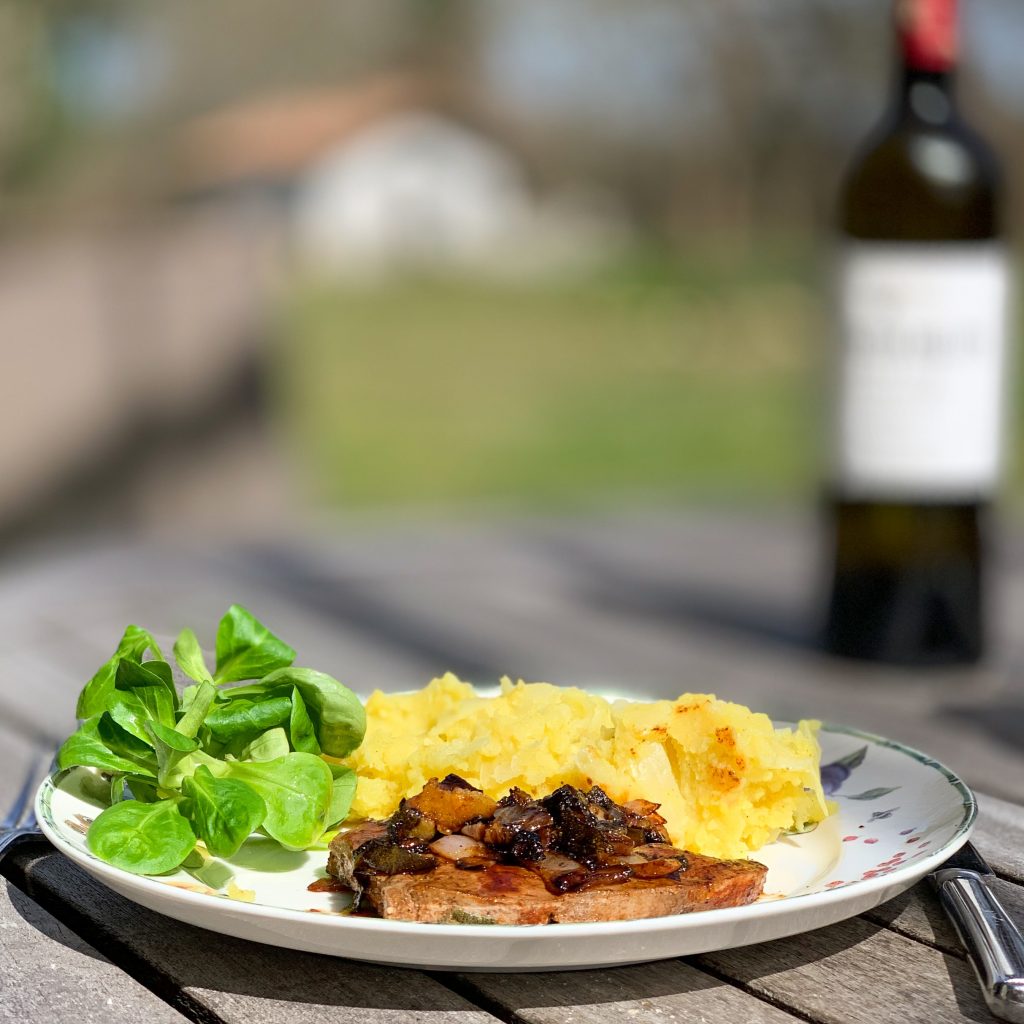
Liver in balsamic vinegar sauce I saw a picture in British newspaper that said everything about France, and in particular, Bordeaux. It was of a couple sitting outside on a restaurant terrace in the centre of Bordeaux (the Place de la Victoire, as it happens). They were calmly eating their dinner, and drinking their obligatory red wine, while rioters and demonstrators caused visible commotion in the background. There was even a ‘fire of wrath’ burning close-by.
The photo reminded me of the time, many years ago, that we had a lunch booking at a Michelin-starred restaurant in Auxerre. It was before GPS and, as we didn’t have a map, we had to stop and ask a policeman for directions to the restaurant. The time was approaching 1pm and the policeman, panicked at the idea that we were going to be late for our table, not only directed us to the restaurant, he also held up the traffic flow in both directions to allow us to do a U-turn! The French have always had their priorities straight.
Liver health benefits
Liver should be organic, preferably, and very fresh. It will be improved greatly by being soaked in lemon juice for several hours before cooking. This improves the texture, and draws out any impurities. Liver is an extremely high-quality source of protein, as it provides all of the essential amino acids. In addition it provides:
- Vitamin B12, which helps the formation of red blood cells and is also involved in healthy brain function.
- Vitamin A, which is important for normal vision, immune function and reproduction.
- Riboflavin (B2), which is important for cellular development and function, and helps turn food into energy.
- Folate (B9) which is an essential nutrient that plays a role in cell growth and the formation of DNA.
- Iron, an essential nutrient that helps carry oxygen around the body. The iron in liver is heme iron, the kind most easily absorbed by the body.
- Copper, which activates a number of enzymes, which then help regulate energy production, iron metabolism and brain function.
- Choline, which is important for brain development and liver function.
Recipe for liver in balsamic vinegar sauce (serves 4)
- 4 slices liver (I used calves liver)
- Juice of 2 lemons
- Cornflour
- 1 tablespoon butter
- 1 tablespoon olive oil
- 6 shallots, finely chopped
- Sea salt, freshly-ground black pepper
- 1/2 teaspoon paprika
- 6 tablespoons balsamic vinegar
Marinate the liver slices in lemon juice for several hours. Pat the slices dry and dust lightly with cornflour. Melt the butter and olive oil in a large, non-stick frying pan and gently brown the sliced shallots. Remove the fried shallots and set aside. Add the liver to the frying pan and cook on a fairly high heat, several minutes on each side depending on the thickness of the slices. Season and then add balsamic vinegar, bring to the boil, return the shallots to the pan and serve immediately!